
11 minute read
Oman: In Search of Salalah’s Fickle Permit
Oman: In Search of Salalah’s Fickle Permit
Nestled in Oman’s Dhofar region, Salalah is a captivating blend of ancient history and modern charm. Once a vital port in 13th-century trade routes between Europe and Asia, the city is steeped in legends that trace back to the mythical Queen of Sheba. Today, Salalah enchants visitors with its fragrant frankincense-scented souqs, lush monsoon-fed landscapes, and legendary Omani hospitality. Beyond its cultural allure, Salalah offers worldclass saltwater fly fishing amidst pristine beaches and untouched natural beauty. Whether exploring its storied past or enjoying its vibrant present, Salalah promises a magical and unforgettable experience.
By TREVOR SKINNER and NICK BOWLES // Photos by TREVOR SKINNER, NICK BOWLES, JOHANN DU PREEZ

Salalah, the ancient capital of Dhofar, was an important port in trade across Europe and Asia in the 13th Century but it’s magic goes back much further. Local legend has it that the ruins at Khor Rori, northeast of Salalah, are those of the Queen of Sheba’s Palace. Archaeologists have subsequently disproved that having dated the ruins starting somewhere around the 3rd Century BCE, more than 500 years after the rule of Queen Makeda. It’s now believed more likely she ruled from Saba in Yemen although she originally came from Ethiopia but after visiting the ruins at Sumhuram it’s not difficult to see how this place conjures stories of biblical proportions complete with jinns, magic, demons, fabled rulers and the founding of a dynasty all under a huge moon and the heady smell of frankincense.
Modern Salalah is no less beguiling but thankfully largely devoid of jinns, demons and biblical characters. It is still, however, dominated by the smell of frankincense in its old souqs and hidden out of the way ancient places. As if continuing with
this tradition the hospitality of the Omanis is legendary and respectful strangers are welcomed with open arms (and often an invite to take coffee or tea with their family).

The Dhofar region is the only place on the Arabian Peninsular that receives the monsoon (locally referred to as the ‘Khareef’) from late May until the end of September. During this time the wind blows, the heavens open, water runs off the mountains, lakes appear out of nowhere and the whole area turns into a green paradise while the rest of the Arab peninsular swelters over summer. In any case, the rest of the year is sub 30 degrees Celsius with very stable weather systems, in other words just about perfect.
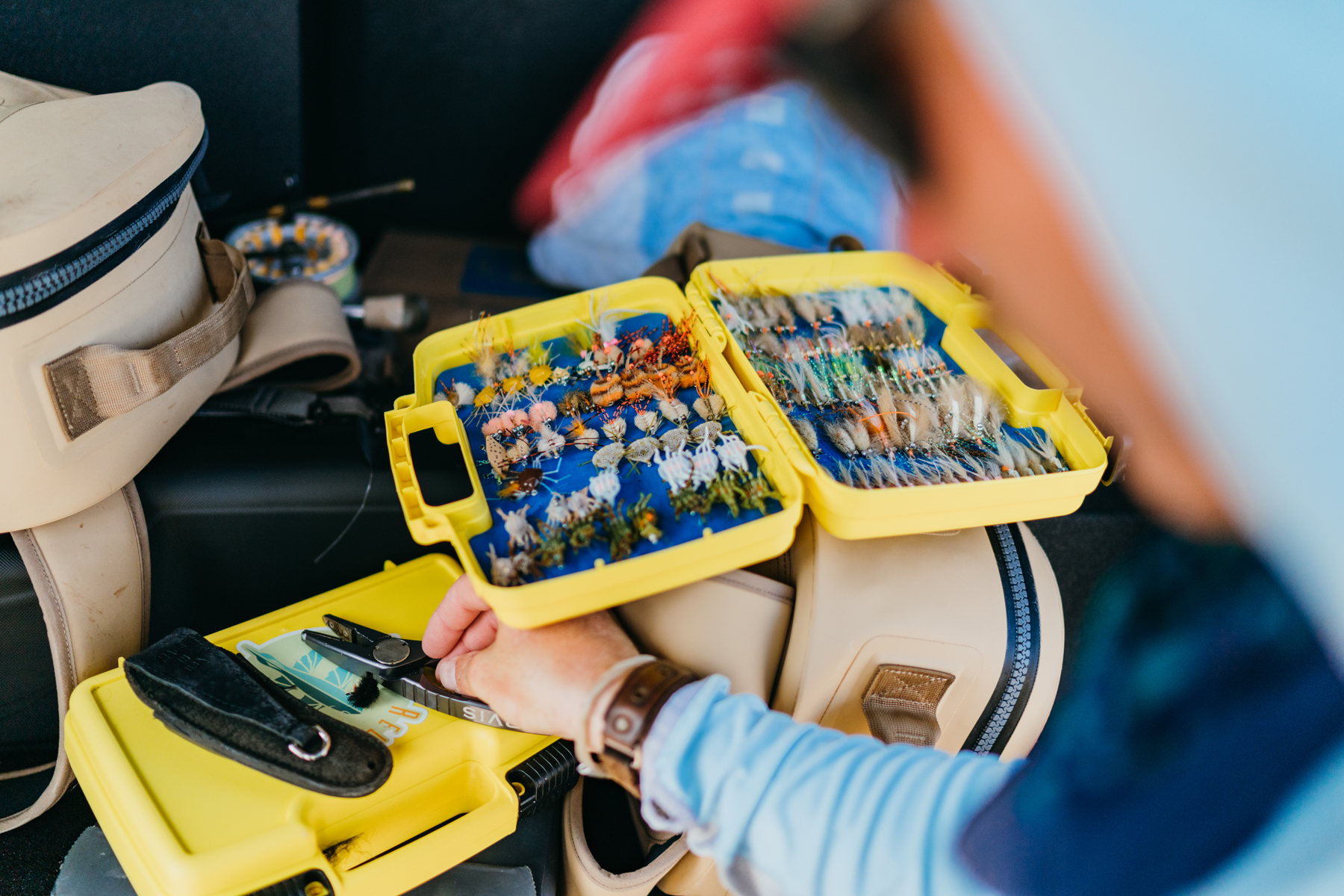
An added bonus
As a place to just visit and soak in the culture Salalah recommends itself in spades, but for the fly fisherman there’s an added bonus. It offers some of the world’s best saltwater fly fishing but keep that to yourself. It’s not just the quality, it’s also the diversity.
The scope ranges from Broomtail Wrasse and Twobar Bream in close amongst rock ledges to Billfish and Tuna offshore with every conceivable type of flyfishing in between.
“The Africanus is unique to the Western Indian Ocean and Oman is probably the only place they are available to fly fishermen”
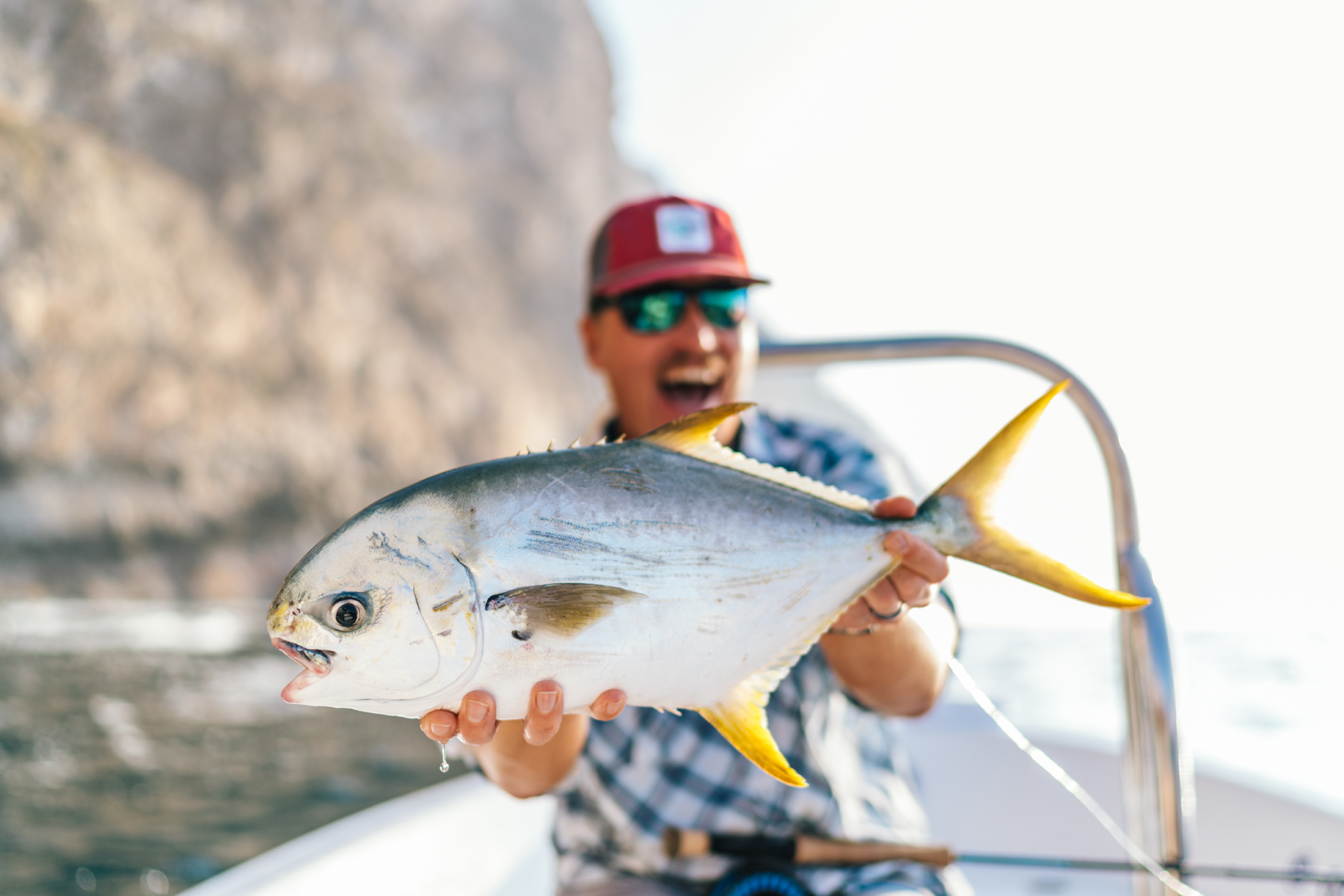

Many adventurous fishermen can think of nothing better than camping and exploring a white sand beach or rocky headland fly rod in hand peering into the waves or across a rock shelf for signs of movement. Southern Oman has miles and miles of largely untouched beaches. Other fisherman like the comfort of a 5-star hotel and a comfortable boat ride to chase hard fighting pelagic species or to access the coastal fishing without sand working its way into every aspect of your being, again Southern Oman is absolutely untouchable.
Permit along the shorelines
However, we go there for the Permit, specifically Africanus (Trachinotus Africanus) but aren’t too disappointed if we get to tangle with Indo Pacific (Trachinotus Blochii) should the opportunity arise. Indo Pacific Permit are generally found along the beaches and are as fickle as their counterparts in the Indian Ocean atolls, Australia and the Pacific.
The Africanus is unique to the Western Indian Ocean and Oman is probably the only place they are available to fly fishermen. Its habitat is unique and, consequently, the approach taken in being able to cast a fly at them is also unique. Africanus is primarily a molluscivore and feeds on the beds of small black mussels that you find along the shoreline although on occasions takes crustaceans and small fish. ‘Nothing unique in a permit eating molluscs’ I hear you say, after all Australia’s Anak permit is colloquially called the ‘Giant Oystercracker’. Apart from its restricted availability, it’s the location of the mussel beds that provides for the uniqueness of chasing Africanus.
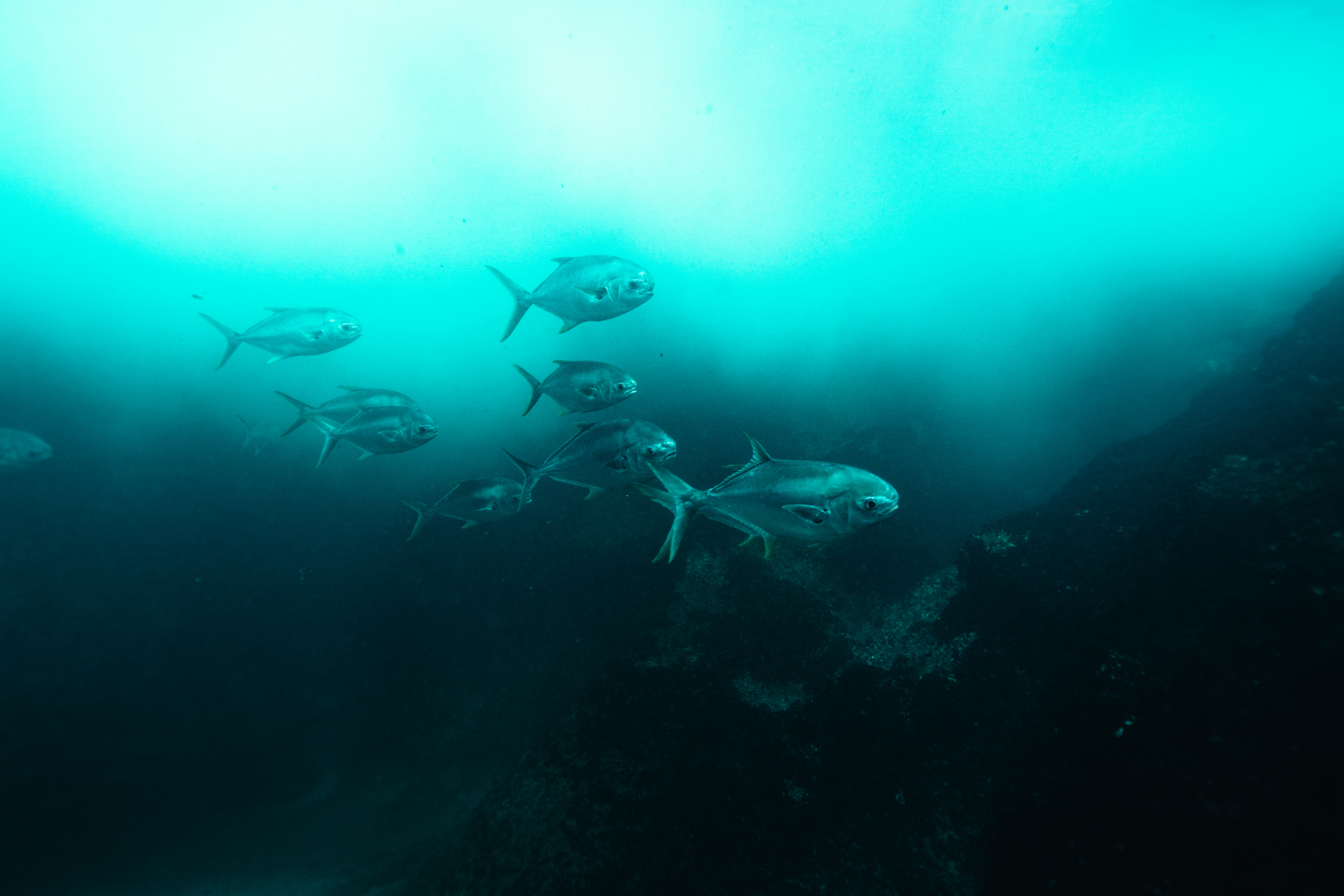
The beds are on narrow rock shelves hard up against the base of towering limestone cliffs, a position made even more spicy by the surges coming in from Indian Ocean which gives the fish sporadic access to their challenging meal as the waves wash over the beds and back off again.
It’s not unusual to see Permit head down, tailing on the mussels only to be cascading down off the ledge like circus acrobats as the wave recedes. Like the Anak this gives the Africanus a gnarled countenance only a mother could love and it’s not unusual to catch one of these tough guys with their nose and forehead heavily scarred.


Targeting Africanus
How does the fisherman fit into all this, you ask? Well, the object of the exercise is to hook fish by putting your fly into the feeding zone as the waves surge in and out. This necessitates some skilfully accurate casting over medium distances from the deck of a heaving well driven boat, impeccable timing and, all the while, still being able to keep contact with the fly to pick up that subtle take.
If the line goes tight then it’s hold on and hope that the fish heads for more open water and away from the various rock ledges and formations that litter the seabed close to the cliffs. Unlike their flats wandering cousins these guys know exactly where the structure is and are not afraid to use it to their advantage. This is our favourite way of fishing for the Africanus and the ‘hunt’ is addictive.
When the tide gets too low for them to access their shallow feeding grounds they fall back into deeper water, extending the fishing window for a while at least. They are much more difficult to tempt to a fly when they are less focused on feeding and congregated away from the mussel beds so tactics have to be adapted accordingly. This is when we see marauding schools of permit patrolling the margins or ‘daisy chaining’ in large numbers. This sight sends even experienced permit fishermen weak at the knees, up to 100 permit milling around in a small space, all oblivious to you, the boat and usually your fly.
“If the line goes tight then it’s hold on and hope that the fish heads for more open water”
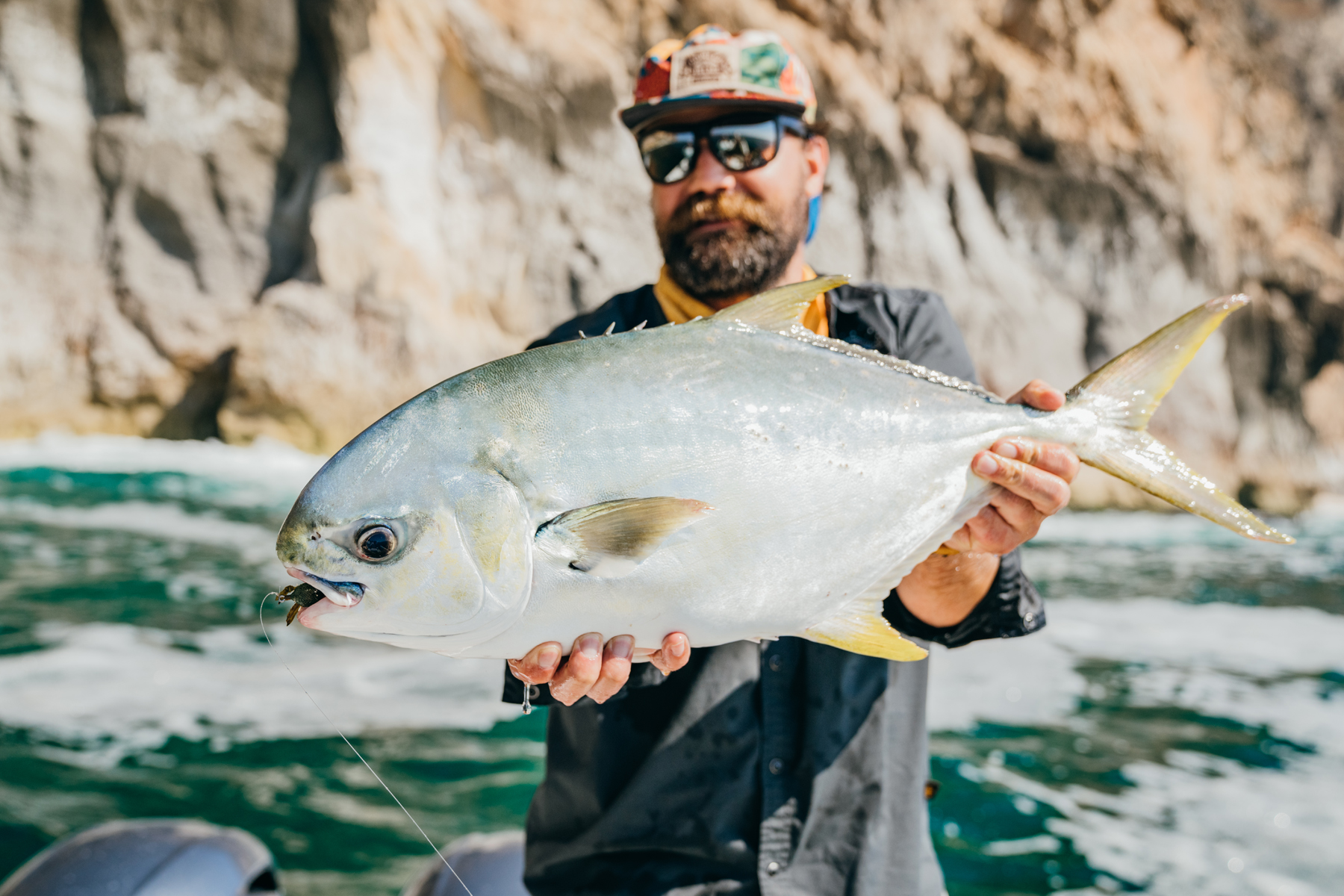

At the extreme of the tide they scatter and disappear into the deep waiting for the rising tide to provide the next opportunity to get a belly full of molluscs. This then necessitates some exploring up and down the coast trying to find the fish as they scatter and, once found, to try and work out a plan that will tempt a take, sometimes that works but often not although the chase is always worth it.
These fish are, after all, permit with all the baggage that comes with that species.
To see a big Africanus in the gin clear water lock onto your fly only to veer away at the last moment suspecting something is not right is heart-stopping stuff but gin-clear water and permit that can just as easily see you as you can them tests the most experienced of us. All this requires that the skipper can put you in the right place at the right time. Unlike most fishing destinations tides and, more importantly, when they occur during their daily cycle is absolutely crucial when fishing Southern Oman for Africanus permit.
Once those fish have spread out away from their feeding grounds and departed the adjacent beaches it’s time to head home, hopefully after some great release photos and much shouting and laughing.


The trip home usually goes one of two ways; either loud animated conversations reliving the highlights of the day’s action or total silence accompanied by a reflective look and broad smiles. Which one doesn’t matter, they are both symptomatic of a great day on the water and that’s the whole reason we do this.
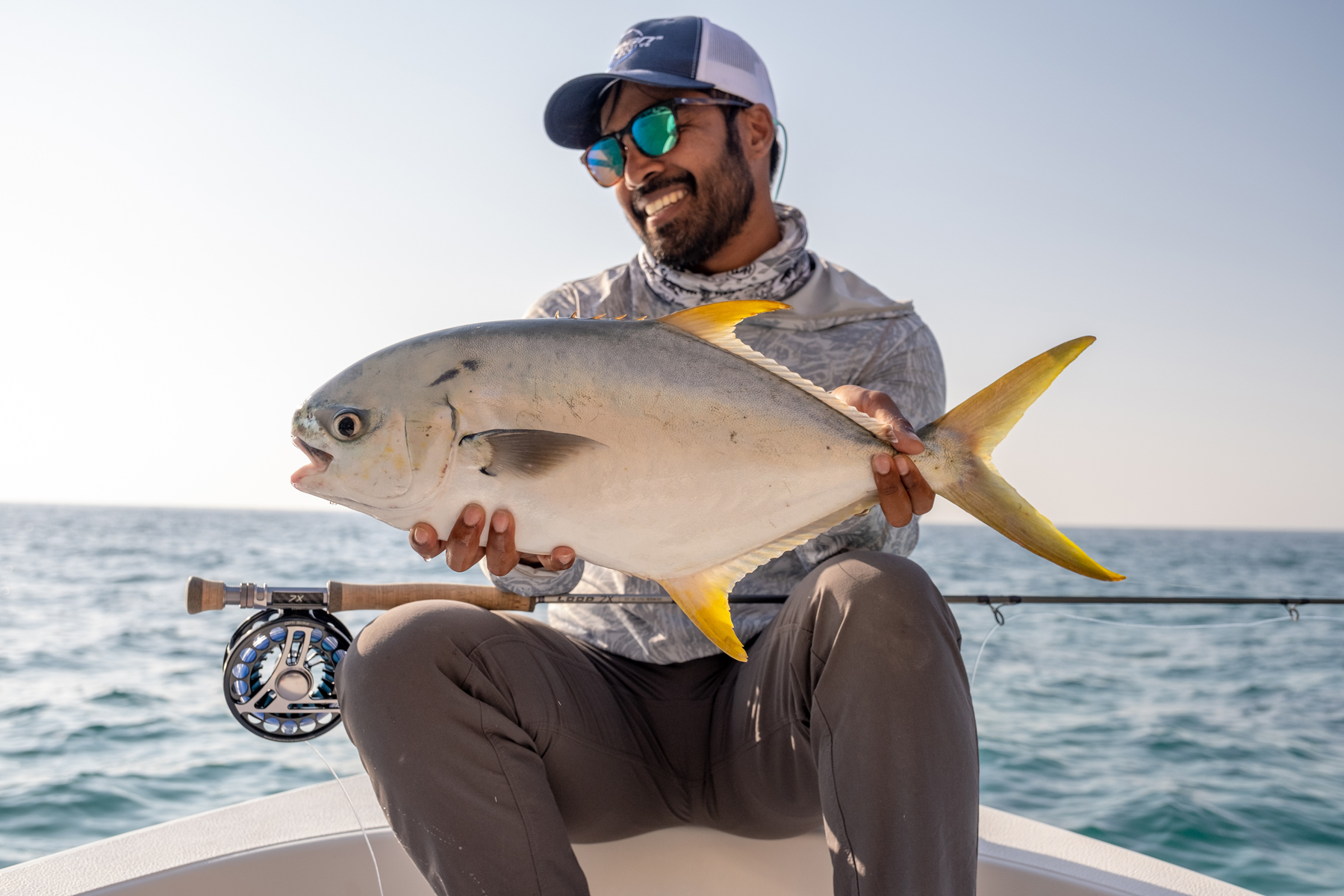
How to tackle Omani permit?
How can we possibly write an article on flyfishing and not mention gear? That would be totally remiss of us. The rod of choice is a fast actioned 10 weight, anything lighter will be like taking a knife to a gun fight. These fish, once hooked, don’t mess around and even when you can get them away from the feeding zone and into deeper water, they will make several runs looking for structure. The usual advice regarding saltwater reels applies here, good quality strong reels are de rigueur with good drags and rigid construction. Recommended lines are either an appropriate WF floating line, intermediate tip or full intermediate. Intermediate lines work best if you want to do some Permit fishing from the beach but also work well on the boat under the right conditions.
Flies are whatever works at the time and changes to find the right formula are part of the game. First choice would be a smallish dark coloured (olive green is a good one) alphlexo crab. However, more natural crab colours also catch fish at times, we suspect because small crabs also inhabit the mussel beds and get washed around with the waves and we all know Permit love to snack on crabs. Once they’re away from the beds and patrolling the shoreline things get tougher. We’ve found that small baitfish patterns, like a Clouser, in natural colours sometimes works but also so does a spawning shrimp pattern.
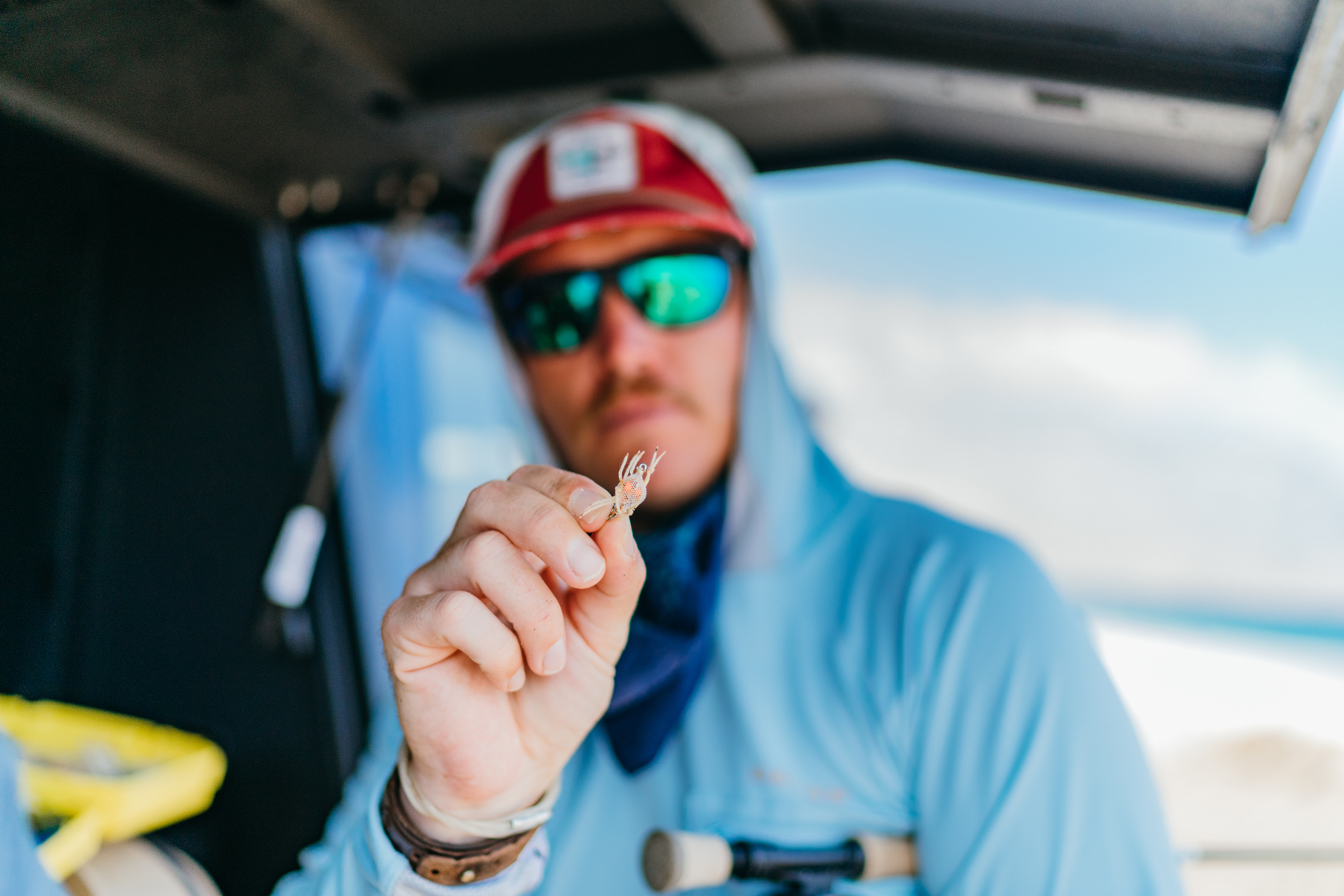

Getting around
Speaking of boats, our charriots of choice are custom built 24 and 27 foot panga style centre consoles specifically designed for fly fishing with both fore and aft casting platforms. They are powered by twin 115hp Yamaha 4 stroke engines and have all the modern electric navigation aids as well as satellite phone.
A typical day will be a 45 minute to 1 hour run inshore to the fishing and a slightly longer run home. We usually have sight of land for the whole trip unless clients ask the skipper nicely and want to go wider and chase pelagics on the way home should conditions allow. Let me just say that it comes highly recommended the Mahi Mahi fishing on fly can be off the charts! Our skippers are all hand-picked, very experienced, fully qualified and licensed.

Fact Sheet:
Oman is positioned at the base of the Arabian Peninsular facing the Indian Ocean. If you follow the coast south from the capital, Muscat, you’ll come to our base just outside of Salalah in the Governate of Dhofar. Arabic is the official language, but English is widely spoken.
Salalah has a very modern airport with regular direct flights from Dubai. Weather during the fishing season between September and April is a very comfortable 25 to 32 Degrees C and, generally, weather systems are stable during the season. More detailed information can be found on our website: www.oceanactivefly.com











